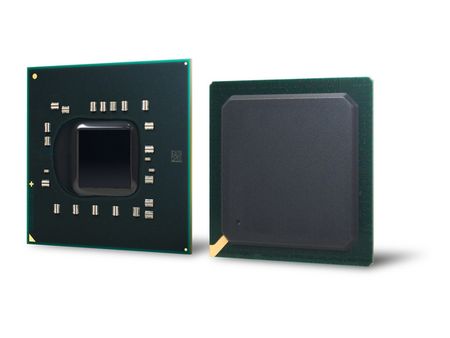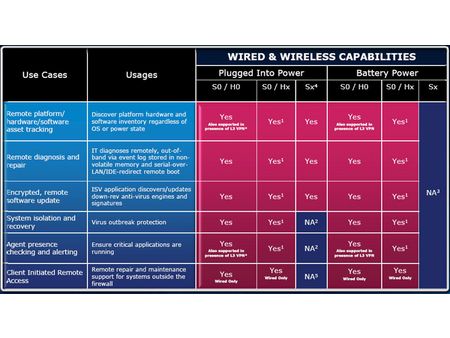Centrino 2 Exposed: A Name Deserved?
Mobile Intel 45 Express Chipset
Intel Upgrades its Core Logic
We had a love/hate relationship with the GM965 chipset, which drove so many Santa Rosa-based notebooks. On one hand, it’s hard to dislike Intel’s core logic. Generally speaking, it’s stable, fast, and on the cutting edge of peripheral and I/O connectivity. At the same time, Intel’s track record for building truly capable integrated graphics cores is shaky at best. In productivity-oriented apps, GM965 provided satisfactory speed. But fire up even a four-year-old first person shooter like Half-Life 2 and your frame rate would crawl along in the single-digit range. Fortunately, the Mobile Intel 45 Express chipset family looks to be better equipped for not only integrated graphics support, but also to work with discrete graphics processors.
Intel is being incredibly coy about talking up the internals of its GM45 chipset, but if the feature list resembles its desktop G45/G43 at all, the Blu-ray playback support referenced in the platform’s official presentation deck includes hardware-accelerated decode for VC-1, MPEG-2 and AVC codecs. We tried playing back a number of standard DVDs using the GM965 graphics core, but always ran out of battery power before they’d finish. Intel’s goal this time around is for each Centrino 2 notebook to make it through a full Blu-ray title before running out of juice.
The chipset’s 3D capabilities are better as well. And this time, DirectX 10 and OpenGL 2.0 are supported from the get-go (through we’re not sure it’ll matter if performance in DirectX 10 games is considered unplayable). As Intel readies the GM45 memory controller hub, we’ll take a more critical look at the core’s performance and composition.
Perhaps more significant to system builders is the integrated core’s display output support, which includes both DisplayPort and HDMI — seemingly similar interfaces that are actually good for different things. As Bruce Montag, a Dell technologist, explains in his blog, HDMI is considered a consumer electronics interface, best thought of as the replacement for S-video and component connections in a home theater. DisplayPort, on the other hand, is the digital interface positioned to succeed DVI, VGA and LVDS. Though DisplayPort is still in its infancy, we’ve already had a pair of enabled workstation-class cards from AMD come through our lab (FireGL V7700), along with a 30” Dell monitor, and have seen the technology work flawlessly.
The chipset boasts two more graphics-related features that Intel ripped straight out of AMD’s Puma playbook. One, CrossFireX support, is really only an extension of the company’s desktop core logic. We’ve already spoken to representatives at OCZ Technology who say their Centrino 2 launch models will wield a pair of discrete GPUs rendering cooperatively on a PM45-based motherboard, forgoing integrated graphics completely.
Intel says that the other feature, switchable graphics, is a response to OEM customers that’d like to build notebooks on integrated platforms with discrete add-in boards included. The switchable graphics feature swaps between the built-in core or add-in board without rebooting, depending on a power policy (wall power versus battery) or a user-configured setting.
Get Tom's Hardware's best news and in-depth reviews, straight to your inbox.
In order to feed the faster front side bus and revamped integrated graphics core, Intel nudges its 4-series chipset toward dual-channel DDR3 memory support. The effect of DDR3 is two-fold. First, it reportedly offers a 25% TDP improvement versus DDR2. Second, at 1066 MHz (the fastest SO-DIMM speed validated with GM45), you’re running synchronous memory and FSB clocks, not to mention delivering more bandwidth to the 533-MHz graphics core.
As you move away from the GM/PM45 memory controller and down through the ICH9M southbridge, a lot of the technology starts looking more familiar. Enhanced Matrix Storage Technology, for instance, gives the platform SATA 3 Gb/s support, eSATA connectivity and RAID 0/1 if your notebook is big enough for two drives. Systems equipped with Intel’s ICH9M-Enhanced I/O controller get access to an additional feature called Rapid Recover Technology, used to maintain system backups.
Current page: Mobile Intel 45 Express Chipset
Prev Page Core 2 Duo: From V8 To Twin-Turbo V6 Next Page New Networking Options-
santos79 The Montevina chipset also introduces support for 8GB of RAM. IMO that's a major advantage of the Centrino2 and should have been mentioned in the article.Reply
While 4GB more than enough for now, it might not be enough in 2-3 years. -
silversound Thats nothing close to a revolutionary upgrade like the core2 from pentium4, only FSB and some memory upgrade on the motherboard; PC6400 is so last year for desktop. Certainly do not deserve the name change, i think just a marketing attempt try to stimulate the sales.Reply -
cangelini silversoundThats nothing close to a revolutionary upgrade like the core2 from pentium4, only FSB and some memory upgrade on the motherboard; PC6400 is so last year for desktop. Certainly do not deserve the name change, i think just a marketing attempt try to stimulate the sales.Reply
Yeah, fairly underwhelming overall--at least until we see hardware from Intel. -
mrmessma I would like to point out that a Z06 gets better mileage (city and highway) than a GT-R, V8 vs TT V6, while both having very comparable power and lap times depending on the track style. Just putting it out there, because I know quite a few were thinking it. Haha.Reply -
cangelini mrmessmaI would like to point out that a Z06 gets better mileage (city and highway) than a GT-R, V8 vs TT V6, while both having very comparable power and lap times depending on the track style. Just putting it out there, because I know quite a few were thinking it. Haha.Reply
I'd argue that it depends on how you're driving the car ;-) I have a much easier time burning through a tank in my V8 than I ever did the bi-turbo V6. -
mrmessma Ok, yes many V8 suck a lot of gas often being paired to heavier vehicles. But I would still wager a quality V8 vs a quality twin turbo V6 have very similar appetites. A very nitpicky thing to say, I will admit.Reply -
cangelini mrmessmaOk, yes many V8 suck a lot of gas often being paired to heavier vehicles. But I would still wager a quality V8 vs a quality twin turbo V6 have very similar appetites. A very nitpicky thing to say, I will admit.Reply
No worries ;) More than anything I was trying to make a brute force vs. finesse analogy--probably could have picked a better subject, but I'm a car guy. -
JonnyDough "The Lost World (what a horrible sequel that was)."Reply
I'm sorry, is this a blog?
If you're going to put your opinion about all sorts of silly things in articles, then please post the article as a BLOG and not some type of news story. I think we (the readers) have been over this. -
cangelini JonnyDough"The Lost World (what a horrible sequel that was)."I'm sorry, is this a blog?If you're going to put your opinion about all sorts of silly things in articles, then please post the article as a BLOG and not some type of news story. I think we (the readers) have been over this.Reply
Thanks for the feedback!


